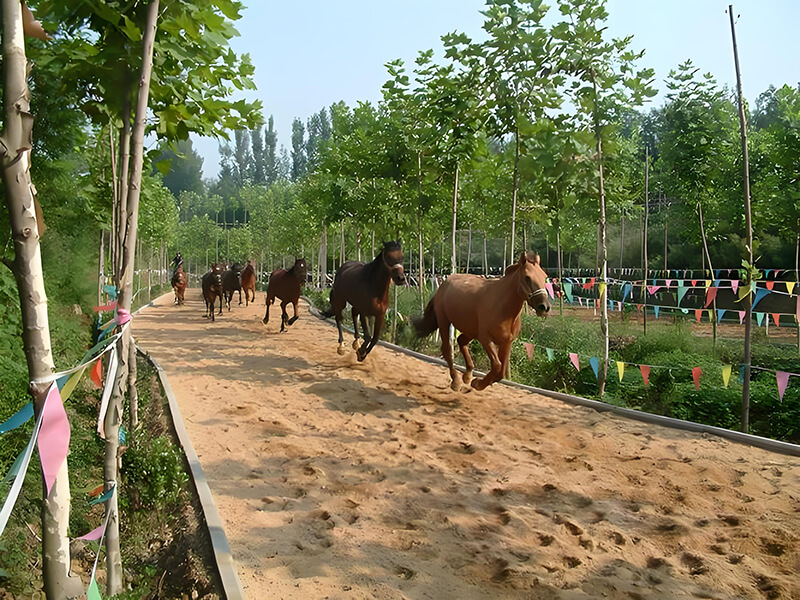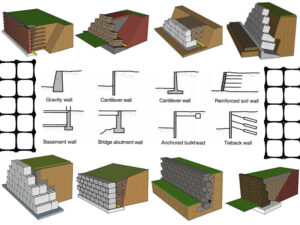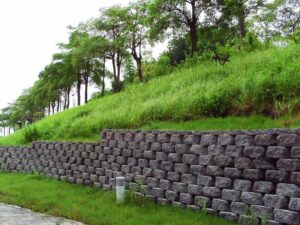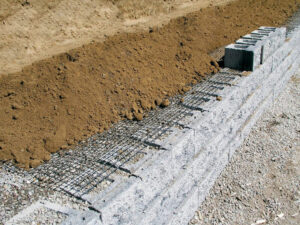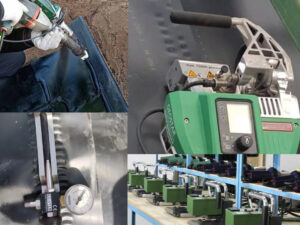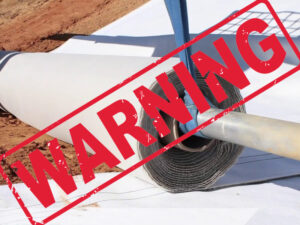Geotextiles play a very important role in the drainage system of horse arenas. For example, geotextiles are used in underground drainage channels to wrap pipes and gravel as screens and are laid above the subbase to provide more stable support, keep the subbase and gravel separated, etc.
Therefore, in this article, QIVOC will introduce the application of non-woven membranes in horse arenas in detail in the following five aspects. Of course, if you are engaged in cattle breeding, you can also refer to this article and use geotextiles in cattle farms.
Geotextile used in drainage ditches for filtration
Groundwater can weaken a site’s foundation (foundation and subbase). Groundwater is usually removed through drains.
A French drain is a buried, gravel-filled trench with an (optional) porous drain pipe at its base. It works by collecting excess water at one location and using gravity to transport that water to an outlet where the excess water can be conveniently disposed of.
Drainage channels are usually located on the perimeter of the site.
French drain systems need to ensure a maximum slope of 2% from the highest point to the drain outlet. Building a French drainage system requires some major excavation and can simply remove excess groundwater near the site.
One potential problem with underground drains is clogging with fine soil particles.
Therefore, it is common practice to use geotextile filter cloth wrapped around the pipe and gravel as a screen.
While geotextile can allow water to pass through while filtering most fine particles, it will eventually clog and prevent water from entering the drain.
To prevent the geotextile from clogging during use, this requirement is related to the filter pore size of the geotextile and the size of the soil particles allowed to pass through. Laboratory filtration performance tests can be used to determine whether the soil and candidate geotextile filter materials match.
If the materials are chosen appropriately and installed correctly, geotextiles can cost-effectively solve filtration problems during underground drain drainage.
A French drain system can be located beneath a swale so that both surface and underground water storage can be treated.
Geotextile fabrics are used to prevent soil erosion
Soil that is too saturated with water cannot provide support for riding and will severely challenge the suitability of the site.
Without improved water management, some sites and soil conditions will not be able to support building or riding activities. Poorly drained, saturated soil with high water content is not strong enough to support the weight.
Think of the difference between walking in relatively dry soil and walking in saturated soil, which we call “mud.”
Mud cannot support weight, and it moves horizontally during movement, leaving footprints, potholes, and ruts at the end of the movement.
For some horse arenas, oversaturated soil properties are unavoidable.
Then, for sites with very poor drainage or high water tables, either the site needs to be raised above the surrounding saturated soil, or drainage ditches need to be added around the perimeter of the site to lower the water table.
Water treatment in gutters should be underground, and for arena surfaces elevated above the surrounding ground, water should be handled through open or narrow ditches. When constructing drainage ditches, geotextile fabric should be installed for filtration to prevent the loss of soil particles.
The benefit for the site is that drainage in trenches and output areas can be seen and monitored. Either solution works well for maintaining dry subbase and base layers.
Non woven membrane used for water interception trenches
The installation of interceptor trenches lowered the site’s water table. Dig a catchment trench about 6 feet deep around the perimeter of the site, fill it with coarse gravel, and place a porous drainage pipe at the bottom.
When the selected site has a pronounced downslope drainage system, no matter how shallow, interception trenches can be located on either side of the long side of the site.
On a flat site, interception ditches may be required on both the long and short sides of the site to move groundwater away from the site.
Slope the catch trench trench at a 1% slope to an area where the accumulated water can drain away. It then flows downhill into a stream (which is “clean” groundwater, rather than surface water containing particles and nutrients), or into a pit designed to resemble a septic tank system.
On sites with upslope topography, where surface water and groundwater converge at the intersection of sloping and flat terrain, interception ditches are necessary to divert surface water and groundwater.
Interception ditches can be spaced 100 feet apart so that lateral flow does not exceed 50 feet from the center of the site.
For extra-wide sites, a third interception ditch should be installed along the center line of the site before construction of the site’s base layer begins. These trenches are used to collect and divert groundwater, so large amounts of water are not expected to flow down through the site foundation into the trenches below.
In addition to interception trenches that effectively lower the water table, the use of geotextile materials above a compacted subbase provides more stable support for the base material than native soil because the geotextile provides late tension support between layers.
This design, with deep interception trenches and geotextile layers around the perimeter of the site, is expensive to construct and requires the site to be available in most weather conditions to be cost-effective in extreme situations.
Geotextiles are used to separate the subbase and gravel layers
Although this design is rare, there are some successful cases of adding a chronic drainage layer of rock material between the subbase and the base layer.
This rock drainage layer is designed to divert groundwater from below and prevent occasional downward erosion of the site surface.
This layer consists mostly of gravel passed through a 3-inch screen, with a 6-inch gravel layer placed over the compacted subsoil; a geotextile layer is also required to keep the subbase and gravel layers separated.
Rock drainage layers are porous structures that provide horizontal drainage. One thing to note is that on a site where the water table is always high, this gravel layer will frequently become saturated and draw water into the base material, which is undesirable.
This gravel layer can only effectively divert a small amount of groundwater and cannot prevent surface water from eroding the site. A gravel layer may also be part of the site architecture to allow some water to pass through the base material, although this design is less common.
Geotextiles fabric used for surface water treatment at horse arena
Intercepting ditches can be used to collect or divert surface water at higher locations, thus preventing low-lying sites from being washed away.
A ditch is usually a shallow, wide, turf-covered depression on the side of a riding area. Depending on the amount of water that needs to be treated, they are usually about 2.4 meters to 6 meters wide and about 15 centimeters to 30 centimeters deep.
The vertical and horizontal ratio from both sides of the trench to the lowest point is 1:3. The lowest point should be planted with lawn and wide enough for mowing and maintenance.
The entire ditch should be inclined 1-2% toward the water storage area. Slopes with steeper slopes may be covered by large pieces of drainage rock. If drainage rock is required, the intercepting ditch should be isolated by a fence to prevent injuries caused by horses’ hooves striking the rocks.
In the same way, using a fence to enclose a catch ditch with a lawn at the bottom can effectively prevent damage to the lawn caused by horse hooves and extend the service life of the catch ditch.
Since the interception ditch with a lawn depression at the bottom is relatively moist and is often more susceptible to the impact of the horse’s movement, the interception ditch around the riding venue should maintain a buffer range of 6 meters to 7.6 meters between the venue and surrounding facilities.
The construction of interception ditches can effectively treat surface water, thereby drying the racecourse surface. When constructing interception ditches, geotextiles should be laid to reduce soil water flow and ensure the stability of the foundation.
The retention area of a drainage system is used to control precipitation from the riding area, and the gutters of outdoor areas can be constructed as a permeable area or filter filled with plants.
It may be a long, gently sloping ditch or depression covered in vegetation, or a wide, flat area with little slope surrounded by a berm or embankment.
Ramp access is more likely to be located where the riding area is. Specific management of infiltration areas is not required, but maintenance of vegetated areas does.
In the end
Geotextile is very important in the construction of the drainage system of the horse arena. It plays an irreplaceable role in French drainage channel filtration, interception trench filtration, and separation of the subbase and gravel layer. Therefore, geotextile fabrics are very suitable for use in horse arena or cattle arena, which can reduce the expensive cost of site construction.
QIVOC provides high-quality and cheap geotextiles, please contact us for consultation.

